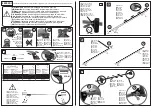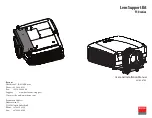
MEDEA Programming Manual
49
o
Double Balance
: This must be used when the detector is connected to the input using the double
balancing wiring diagram (see
Installation Manual
for details). By means of three voltage
thresholds it recognises stand-by status, intrusion signal, sabotage signal due to short-circuiting
of the wires and the sabotage signal due to cutting of the wires or opening of the tamper switch.
Complies with EN 50131 Grade 2 and Grade 3.
o
Triple Balance
: This must be used when the detector is connected to the input using the triple
balancing wiring diagram (see
Installation Manual
for details). By means of four voltage thresholds
it recognises the following signals: stand-by, intrusion, sabotage due to short-circuiting of the
wires, sabotage signal due to cutting of the wires, opening of the tamper switch and masking for
detectors equipped with this function. Complies with EN 50131 Grade 2 and Grade 3.
o
Tandem
: This can be used to connect two detectors to the same terminal defined as TANDEM
input, singularly identifying stand-by status, intrusion signal, sabotage signal due to short-
circuiting of the wires and the sabotage signal due to cutting of the wires or opening of the tamper
switch.
The following diagram shows the states recognised by the different balancing types:
Recognised State
Single balancing
Double balancing
Triple
balancing
Standby
■
■
■
Intrusion
■
■
■
Sabotage by short-
circuiting the wires
■
■
■
Sabotage by cutting
wires
■
■
Fault or masking
■
Table 11 - States recognised by different balancing types
o
Shade
: This must be used when a specific detector for roller shutters is connected to the input.
The movement of the shutter (opening or closing) makes the detectors generate a series of
pulses, proportional to the movement of the shutter. The control panel monitors two configurable
parameters: number of pulses and pulse time out (timeout starts when the first pulse is recorded).
When both parameters are met, the alarm is triggered. For example, by setting number of pulses
= 10 and time-out pulses =20 seconds, if the shutter movement generates 10 pulses within a
maximum of 20 seconds, the alarm is triggered. This is not EN 50131 compliant.
o
Inertial
: The detector connected to the input is an inertial type. The operating principle is the
same as that of the shutter detector, only the type of pulse generated and the frequency change.
This is not EN 50131 compliant.
Customization:
For each input programmed as single, double, triple balance and tandem, the resistive
value expressed in K ohm of each resistor can be programmed to simplify the system creation. Eight
customisations are available.
Double-click on the PrIO line to open a pop-up window that can be used to enable and disable the PrIO,
select whether it should be an input or an output (parameter that cannot be changed for the first 6 points
of the control panel, which are exclusively inputs) and define the type of contact (only if input) and the type
of customisation associated with it. Click on the
Save
button to save the changes, the
Close
button to
close the window and not save the changes.
















































